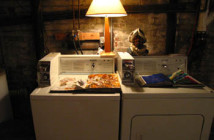Last week a writer sent me a copy of Samson Projects' press release from the show Off My Biscuit, Destroy the District and a note saying, “I've never seen it's kind before but THIS IS ART WRITING.”
Okay, so he didn’t use all caps…or any, really, but the question is clear and taking an editorial stance suddenly seems important. What is art writing?
Artists explain themselves, critics explain artists, artist/critics explain themselves through the work of other artists, and everyone justifies their existence to a world that cares very little about what they say or do. After reading a few artists’ statements you almost can’t blame them (I just re-read my first: I quote Derrida and use the phrase “hegemony of the post-modern discourse”). As simply as possible, it is writing that says something about an immediate experience of a work of art and how that experience relates to art in general.
There are three types of art writing in Big Red & Shiny: editorial, journalistic, and critical. In editorial writing one focuses on art through oneself, and you only need look at the work long enough to develop a personal reaction. Great editorial art writing comes about when the writer’s voice is compelling. Journalistic writing looks at art within the larger context of history, community, institution, or trend. It involves research and a good understanding of the issues in the present that make the art topical. Critical writing approaches work rationally as well as emotionally and makes a value judgment as to the work’s success or failure. Good criticism requires thorough examination of the work itself and the self-awareness to analyze one’s reactions in a larger context.
Art writing can enrich and widen the scope of art appreciation, which is good for everyone. For Thomas, Camilo’s piece is Art Writing: it deepens his understanding and appreciation of the exhibited work. I’m not certain I agree, but my opinion is beside the point: Big Red & Shiny offers a forum with standards, not a mission. We maintain a level of content and clarity but beyond that we are not here to pass judgments: the broader the dialogue the stronger our voice.
Links:
Samson Projects



